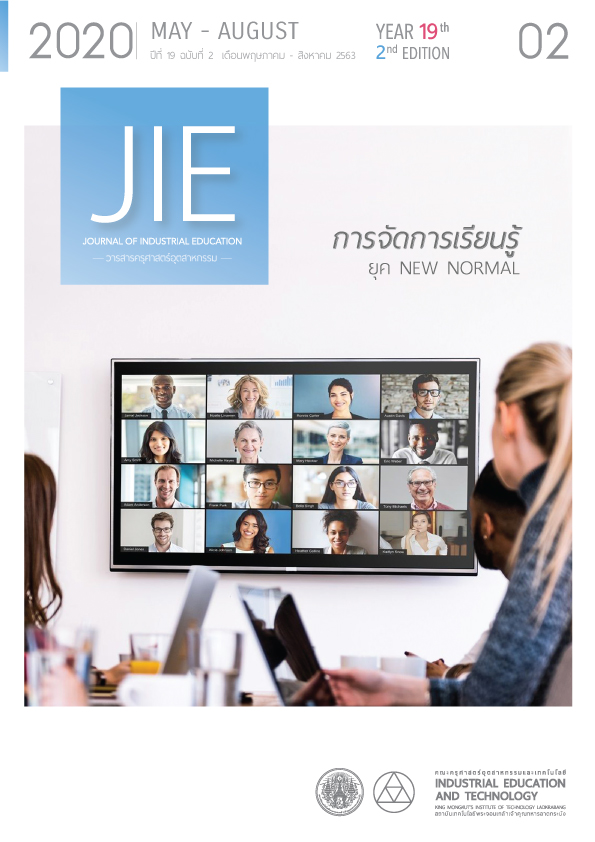2-DIMENSIONAL AUGMENTED REALITY TECHNOLOGY : MILLING WORKPIECE ALIGMENT USING AUTOMATED MACHINE
Keywords:
Augmented Reality, Machine, Workpiece AlignmentAbstract
The objectives of this research were to 1) develop and determine the efficiency of the instructional media with 2D augmented reality technology for centering workpiece on a CNC milling machine and to 2) compare the learning achievement of students to the predetermined standard. The samples in this study included 30 second-year students from the high vocational certificate of the Department of Industrial Technology, Eastern College of Technology. The research instruments consisted of the instructional media with 2D augmented reality technology for centering workpiece on a CNC milling machine, a class exercise, and a post-learning test. In addition, the index of Item–Objective Congruence (IOC) ranged from 0.60 to 1.00. The difficulty level of each question was between 0.20 to 0.80. The item discrimination was from 0.25 to 0.75. Also, the reliability was 0.88. Furthermore, the statistical values for analyzing were average, standard deviation, and instructional media efficiency. The learning achievement was compared to the standard by using a t-test.
The results showed that 1) the quality assessment score of the instructional media with 2D augmented reality technology was considered as a very good level, = 4.51, S.D. = 0.31, which was the overall, 2) regarding the efficiency of the instructional media with 2D augmented reality technology media, the procedure efficiency (E1) was 81.08 and the performance of result (E2) was 83.55, being higher than the predetermined standard of 80/80. Moreover, 3) the comparison of the learning achievement found that the average overall of the learning achievement score was 25.06 with a standard deviation of 2.62, which was higher than the predetermined standard with a significant level of .05
References
Thailand Development Research Institute. 2014. Proposal on the reform of the Thai education system. [online]. Retrieved from http://pokpong.org/wp-content/uploads/education-reform-proposal.pdf (April 10, 2019).
Office of the Education Council. 2017. The National Scheme of Education BE 2560-2579. [online]. Retrieved from http://www.lampang.go.th/public60/EducationPlan2.pdf (April 10, 2019).
Jiraporn Pakorn. 2018. AR (Augmented Reality) Virtual world technology combines the real world. [online]. Retrieved from http://www.scimath.org/article-technology /item/7755-ar-augmented-reality. (April 10, 2019)
Ladawan Saothong. 2013. Augmented Reality. [online]. Retrieved from http://ladawan24nong.blogspot. com/2013/ 08/virtual-classroom.html. (April 10, 2019)
Chaiyong Phromwong. 2013. Developmental Testing of Media and Instructional Package. Silpakorn Journal of Research Sciences, 5(1), p. 5-20.
Patcharaporn Khunsombut. 2018. Supplymentary Learning Media by Augmented Reality for The Connection of Circuits and Electronic Devices on Protoboards. Master of Science in Industrial Education in Electronics, Faculty of Industrial Education and Technology, King Mongkut’s Institute of Technology Ladkrabang.
Suphot Phwngsiri. 2016. The Development of Augmented Reality Manual on the Use of Body Fat Measurement. Master of Education in Educational Technology and Communications, Faculty of Physical Education, Srinakharinwirot University.
Bussarakam Tongpet. 2020. Creating and Searching Effectiveness for Teaching Media using 2D Augment Reality via Google Classroom for Resister in Subject of Fundamental Electrical Engineering for Bachelor of Science in Technical Education. The 12th National Conference on Technical Education, (March), p. 27-33.
Sanatta Siklom. 2016. Learning media by augmented reality on microcontroller.Master of Science in Industrial Education in Electrical Communications Engineering, Faculty of Industrial Education, King Mongkut’s Institute of Technology Ladkrabang.
Supat Boonyou. 2016. Basic Electronic Instructional Media by Using Augmented Reality. Master of Science in Industrial Education in Electrical Engineering, Faculty of Industrial Education and Technology, King Mongkut's Institute of Technology Thonburi.
Apida Runwath. 2018. The Development of Multimedia for Local Community Participation. Journal of Project in Computer Science and Information Technology, 4(2), p. 7-16.
Daoratha Weerapan. 2017. The Development of 2D Animated Multimedia Learning Materials About Sufficient Life Via Internet. Valaya Alongkorn Review (Humanities and Social Science), 7(3), p.61-72.
Chanwit Kamcharean. 2019. Use of An Interactive Simulation: Projectile Motion. Journal of Industrial Education, 18(3), p. 13-24.
Downloads
Published
How to Cite
Issue
Section
License
"The opinions and contents including the words in papers are responsibility by the authors."
"ข้อคิดเห็น เนื้อหา รวมทั้งการใช้ภาษาในบทความถือเป็นความรับผิดชอบของผู้เขียน"



